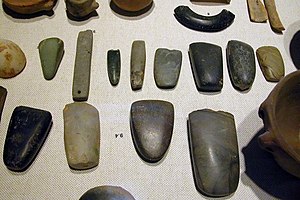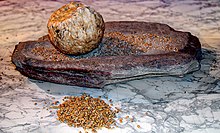In archaeology, a tool stone is a type of stone that is used to manufacture stone tools, or tools that use stone as raw material.
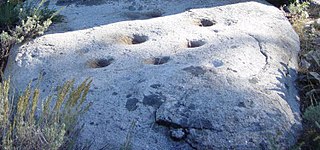
In archaeology, a grinding slab is a ground stone artifact generally used to grind plant materials into usable size, though some slabs were used to shape other ground stone artifacts. Some grinding stones are portable; others are not and, in fact, may be part of a stone outcropping.
In archaeology, lithic analysis is the analysis of stone tools and other chipped stone artifacts using basic scientific techniques. At its most basic level, lithic analyses involve an analysis of the artifact's Morphology (archaeology), the measurement of various physical attributes, and examining other visible features.
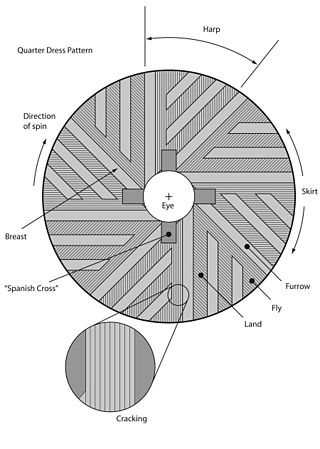
Millstones or mill stones are stones used in gristmills, used for triturating, crushing or, more specifically, grinding wheat or other grains. They are sometimes referred to as grindstones or grinding stones.

A mortar and pestle is a set of two simple tools used to prepare ingredients or substances by crushing and grinding them into a fine paste or powder in the kitchen, laboratory, and pharmacy. The mortar is characteristically a bowl, typically made of hard wood, metal, ceramic, or hard stone such as granite. The pestle is a blunt, club-shaped object. The substance to be ground, which may be wet or dry, is placed in the mortar where the pestle is pounded, pressed, or rotated into the substance until the desired texture is achieved.

In archaeology, a blade is a type of stone tool created by striking a long narrow flake from a stone core. This process of reducing the stone and producing the blades is called lithic reduction. Archaeologists use this process of flintknapping to analyze blades and observe their technological uses for historical purposes.
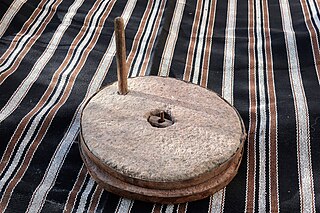
Quern-stones are stone tools for hand-grinding a wide variety of materials, especially for various types of grains. They are used in pairs. The lower stationary stone of early examples is called a saddle quern, while the upper mobile stone is called a muller, rubber, or handstone. The upper stone was moved in a back-and-forth motion across the saddle quern. Later querns are known as rotary querns. The central hole of a rotary quern is called the eye, and a dish in the upper surface is known as the hopper. A handle slot contained a handle which enabled the rotary quern to be rotated. They were first used in the Neolithic era to grind cereals into flour.
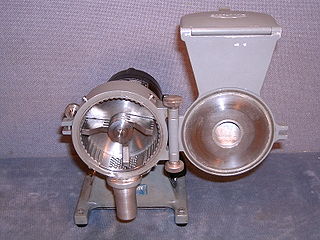
A mill is a device, often a structure, machine or kitchen appliance, that breaks solid materials into smaller pieces by grinding, crushing, or cutting. Such comminution is an important unit operation in many processes. There are many different types of mills and many types of materials processed in them. Historically mills were powered by hand or by animals, working animal, wind (windmill) or water (watermill). In modern era, they are usually powered by electricity.
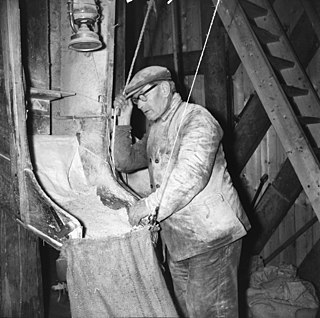
A miller is a person who operates a mill, a machine to grind a grain to make flour. Milling is among the oldest of human occupations. "Miller", "Milne" and other variants are common surnames, as are their equivalents in other languages around the world. Milling existed in hunter-gatherer communities, and later millers were important to the development of agriculture.

A molcajete and tejolote are stone tools, the traditional Mexican version of the mortar and pestle, similar to the South American batan, used for grinding various food products.

A metate is a type or variety of quern, a ground stone tool used for processing grain and seeds. In traditional Mesoamerican cultures, metates are typically used by women who would grind nixtamalized maize and other organic materials during food preparation. Similar artifacts have been found in other regions, such as the sil-batta in Bihar and Jharkhand, India as well as other grinding stones in China.
In archaeology, lithic technology includes a broad array of techniques used to produce usable tools from various types of stone. The earliest stone tools to date have been found at the site of Lomekwi 3 (LOM3) in Kenya and they have been dated to around 3.3 million years ago. The archaeological record of lithic technology is divided into three major time periods: the Paleolithic, Mesolithic, and Neolithic. Not all cultures in all parts of the world exhibit the same pattern of lithic technological development, and stone tool technology continues to be used to this day, but these three time periods represent the span of the archaeological record when lithic technology was paramount. By analysing modern stone tool usage within an ethnoarchaeological context, insight into the breadth of factors influencing lithic technologies in general may be studied. See: Stone tool. For example, for the Gamo of Southern Ethiopia, political, environmental, and social factors influence the patterns of technology variation in different subgroups of the Gamo culture; through understanding the relationship between these different factors in a modern context, archaeologists can better understand the ways that these factors could have shaped the technological variation that is present in the archaeological record.

Ohalo II is an archaeological site in Northern Israel, near Kinneret, on the southwest shore of the Sea of Galilee. It is one of the best preserved hunter-gatherer archaeological sites of the Last Glacial Maximum, radiocarbon dated to around 23,000 BP (calibrated). It is at the junction of the Upper Paleolithic and the Epipaleolithic, and has been attributed to both periods. The site is significant for two findings which are the world's oldest: the earliest brushwood dwellings and evidence for the earliest small-scale plant cultivation, some 11,000 years before the onset of agriculture. The numerous fruit and cereal grain remains preserved in anaerobic conditions under silt and water are also exceedingly rare due to their general quick decomposition.

In archaeology, a flake tool is a type of stone tool that was used during the Stone Age that was created by striking a flake from a prepared stone core. People during prehistoric times often preferred these flake tools as compared to other tools because these tools were often easily made, could be made to be extremely sharp & could easily be repaired. Flake tools could be sharpened by retouch to create scrapers or burins. These tools were either made by flaking off small particles of flint or by breaking off a large piece and using that as a tool itself. These tools were able to be made by this "chipping" away effect due to the natural characteristic of stone. Stone is able to break apart when struck near the edge. Flake tools are created through flint knapping, a process of producing stone tools using lithic reduction.

Cupstones, also called anvil stones, pitted cobbles and nutting stones, among other names, are roughly discoidal or amorphous groundstone artifacts among the most common lithic remains of Native American culture, especially in the Midwestern United States, in Early Archaic contexts. The hemispherical indentation itself is an important element of paleoart, known as a "cupule". Cup and ring marks are also common in the Fertile Crescent and India, and later in the Mediterranean, Atlantic, and Alpine regions of Europe, sometimes associated with complex petroglyphs or megalithic monuments.
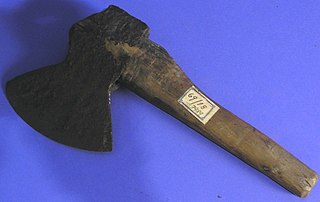
Hafting is a process by which an artifact, often made of bone, stone, or metal is attached to a haft. This makes the artifact more useful by allowing it to be launched by a bow (arrow), thrown by hand (spear), or used with more effective leverage (axe). When constructed properly, hafting can tremendously improve a weapon's damage and range. It is estimated that hafted weapons were most common during the Upper Paleolithic and Middle Paleolithic. It was one of the first tools where hominins took separate elements and united them into a single tool. The development of hafting is considered by archaeologists to have been a significant milestone. It was not only an improvement in the technology at the time; it also showed the progression of the human mind toward a world of complex tool-making.

An axe is an implement that has been used for millennia to shape, split, and cut wood, to harvest timber, as a weapon, and as a ceremonial or heraldic symbol. The axe has many forms and specialised uses but generally consists of an axe head with a handle, also called a haft or a helve.
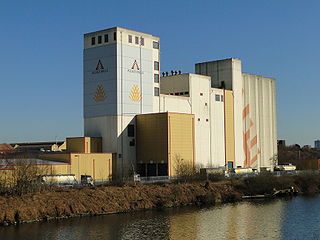
A gristmill grinds cereal grain into flour and middlings. The term can refer to either the grinding mechanism or the building that holds it. Grist is grain that has been separated from its chaff in preparation for grinding.

Starch analysis or starch grain analysis is a technique that is useful in archaeological research in determining plant taxa on a microscopic level. It can also be used in day-to-day life by specialists within the pharmaceutical and food industries in order to determine taxa origins and food quality. Specifically in regards to archaeology though, the identification of starch grains, through this context is done by comparison identification, in which several attributes of the grains are compared to other known samples in order to determine the type. This comparison technique, when done microscopically allows for the specific taxa identification of starch grains found on specific artifacts, such as ground stone tools, within soils, through dental calculus, or found in reference to ceramic vessels. Starch grain analysis can be helpful as a supplement to other forms of study to understanding tool use, agricultural activities, as well as other plant based subsistence strategies, and to reconstruct plant based diets throughout time.
The Vail Pass Camp is a multi-component prehistoric site, situated at the summit of Vail Pass, just below the timberline in Colorado. The camp was occupied for over 7000 years, inhabited by various North American aboriginal groups, and is the first open lithic-scatter site. Thirty-three radiocarbon dates were obtained, ranging from 7320 B.P. to 190 B.P. with most dating to the last 3,000 years. The Vail Pass Camp was most likely discovered in 1887 by T.D.A Cockerell.
